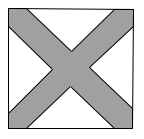2007 AMC 10A Problems/Problem 19
Problem
A paint brush is swept along both diagonals of a square to produce the symmetric painted area, as shown. Half the area of the square is painted. What is the ratio of the side length of the square to the brush width?
![]()
Solution
Without loss of generality, let the side length of the square be ![]() unit. The area of the painted area is
unit. The area of the painted area is ![]() of the area of the larger square, so the total unpainted area is also
of the area of the larger square, so the total unpainted area is also ![]() .
Each of the
.
Each of the ![]() unpainted triangle has area
unpainted triangle has area ![]() . It is easy to tell that these triangles are isosceles right triangles, so let
. It is easy to tell that these triangles are isosceles right triangles, so let ![]() be the side length of one of the smaller triangles:
be the side length of one of the smaller triangles:
![]()
The diagonal of the triangle is ![]() . The corners of the painted areas are also isosceles right triangles with side length
. The corners of the painted areas are also isosceles right triangles with side length ![]() . Its diagonal is equal to the width of the paint, and is
. Its diagonal is equal to the width of the paint, and is ![]() . The answer we are looking for is thus
. The answer we are looking for is thus ![]() . Multiply the numerator and the denominator by
. Multiply the numerator and the denominator by ![]() to get
to get  or $4({\frac{\sqrt{2}}{2}+\frac{1}{2}}})$ (Error compiling LaTeX. Unknown error_msg) which is
or $4({\frac{\sqrt{2}}{2}+\frac{1}{2}}})$ (Error compiling LaTeX. Unknown error_msg) which is ![]()
See also
| 2007 AMC 10A (Problems • Answer Key • Resources) | ||
| Preceded by Problem 18 |
Followed by Problem 20 | |
| 1 • 2 • 3 • 4 • 5 • 6 • 7 • 8 • 9 • 10 • 11 • 12 • 13 • 14 • 15 • 16 • 17 • 18 • 19 • 20 • 21 • 22 • 23 • 24 • 25 | ||
| All AMC 10 Problems and Solutions | ||










